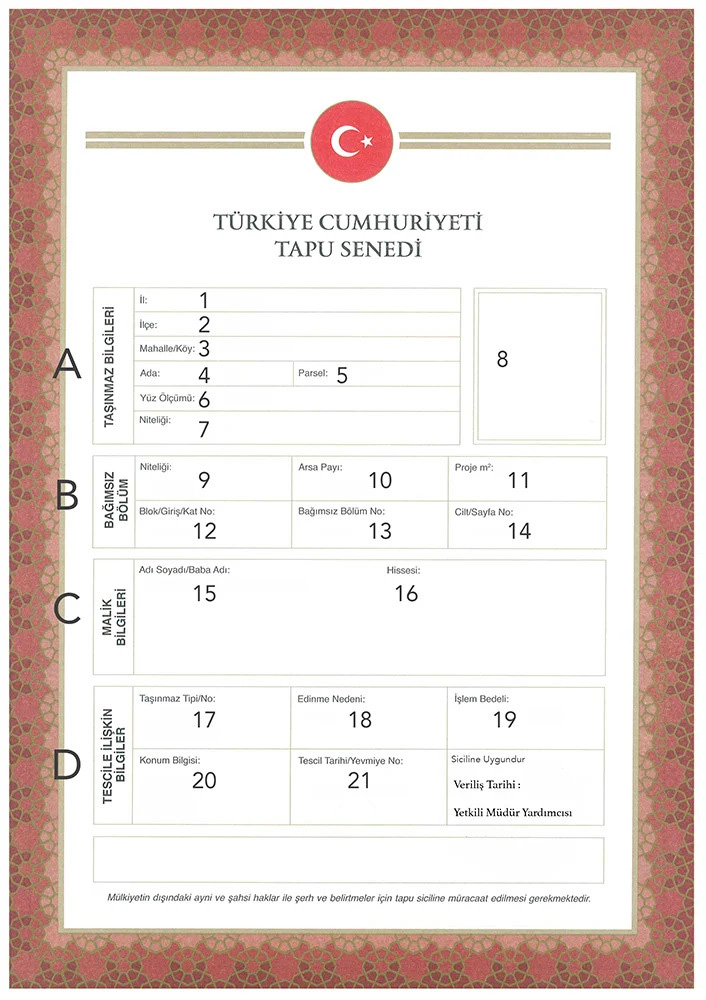Turkish Title Deed
The title deed in Turkey is called “Tapu“. It is an official and legal document to prove ownership rights of a property. It registers the location, owner, type, size information of the property.
The authority of the title deed registry and archive is the General Directorate of Land Registry and Cadastre (Tapu ve Kadastro Genel Müdürlüğü – TKGM). There are title deed offices of TKGM in every city in Turkey. TKGM is a heritage institution of the Ottoman Empire to the young Turkish Republic as one of the oldest corporate is established in 1847 as Defterhane-i Amire.
All properties are freehold in Turkey. Once you own a property in Turkey, you have full ownership rights on it and your family has the right of inheritance (succession) after your death.
There are 3 commonly used types of title deeds in Turkey. The title deed process depends on the current stage of the property. These title deeds are;
1.
Easement Title Deed
This type of title deed is made with the owner and building constructor. They register each section of the property separately, in the sense that a suitable project is planned for construction on a designated piece of land, then the approval of the construction is taken.
2.
Floor Easement (Kat İrtifakı) Title Deed
This is the title deed dividing the project is divided into separate sections. After 70% of the construction is complete, the land registry office briefly proofs that the entire building has been constructed in accordance with the Building Code. The building contractors usually present the properties of the building to be sold to the buyer through this register, in a form in which the features are accurately indicated with details, and after the construction is completed, the contractor applies for full ownership for each title deed.
3.
Ownership (Kat Mülkiyeti) Title Deed
After the construction is complete, this title deed registers the ownership and designates independent sections. Landlords receive it after obtaining housing approval from the municipality, to comply with the project to the Turkish standards and criteria for housing and residence, where the owners have no legal problem furthermore.
How Does Title Deed Conveyance Process Work in Turkey?
Title deed conveyance occurs at title deed offices regarding the seller’s application. Applications are accepted on weekdays until noontime. Buyers do not have to be present at the title deed office during the application.
Required documents for title deed conveyance are as follows:
• The translation and the original buyer’s passport,
• Buyer’s tax number,
• Statement of identity information form,
• Appraisal report,
• Current title deed,
• Seller’s ID
Seller takes the required documents to the title deed office while going for title deed conveyance application. Within the time frame between the application and the final signatures, title deed expenses must be paid. Expenses include title deed conveyance tax, stamp taxes, and circulating capital.
After preparing title deed conveyance documents, the title deed office invites both parties for final signatures by sending an SMS that clarifies the date and time of the appointment. The appointment date depends on the work volume at the title deed office, mostly the same day in the afternoon, within two days at the latest. If any of the parties is a foreigner, a sworn interpreter must be present at the title deed office to explain the terms of the conveyance to the party since the papers are prepared only in the Turkish language. After the seller and buyer sign the title deed conveyance agreement, the title deed is printed by the officers and given to the buyer.
Bodrum White Villas follows the title deed process for its customers as part of free after-sale services from preparing the necessary documents to the final signatures.

TITLE DEED (TAPU) TRANSLATION
Section A contains location information as property address
1. Province / İl
2. District / İlçe
3. Neighborhood or Village / Mahallesi / Köy
4. Island number / Ada No.
5. Parcel No / Parsel No
6. area of the land / Yüz Ölçümü
7. Type of property (Characteristic of the property) / Niteliği.
8. Personal Photo / Fotoğraf
Section B contains the information of your property
9. Type of property / Niteliği
10. Owner’s share of the land / Arsa Payı
11. square meters of property / Proje m2
12. Block number / Entrance / Floor number / Kat No – Blok No – Giriş
13. Apartment number / Bağımsız Bölüm No
14. Page number & record number / Cilt / Sayfa No
Section C contains information about the owner of the property
15. The name of the owner or owners. More than one owner it can be written in the title deed.
16. Shares / Hissesi
Section D includes archive information for the Land Registry Department
17. Property type / number / Taşınmaz Tipi / No
18. Property ownership type if it is [inherited, sale, donated] / Edinme Nedeni
19. Property value / İşlem Bedeli
20. Information about the address / Konum Bilgisi
21. Registration Date / Registration Number / Tescil Tarihi / Yevmiye No
